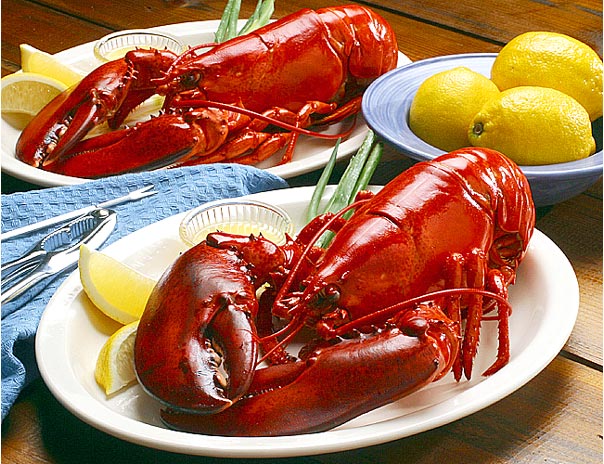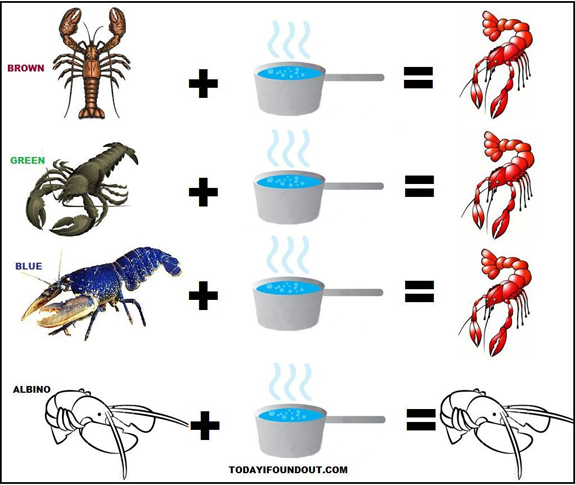Why Lobsters and Crabs Turn Red When Cooked
 Today I found out why crabs, lobsters, crayfish, shrimp, and some other crustaceans turn red/orange when cooked.
Today I found out why crabs, lobsters, crayfish, shrimp, and some other crustaceans turn red/orange when cooked.
Typically, the exoskeleton of most crustaceans has a blue-green to grayish color and sometimes they appear a brown or olive green, with just a hint of red; with a few exceptions like the blue and yellow lobsters and crabs. The exoskeletons of such creatures are made up of several pigments, one of which is a carotenoid called astaxanthin, which provides its reddish coloring (astaxanthin is the same carotene that gives salmon its color).
At normal temperatures and when alive (in other words, when we’re not dumping them in boiling water or grilling the poor guys), the astaxanthin pigments are hidden because they are covered with other protein chains that give their shells the bluish-gray or brownish-green color we see.
Exposure to heat destroys this protein coating,while the carotenoid pigment, astaxanthin still remains stable. So when you cook a crab or lobster or its other tasty crustacean friends for that scrumptious meal you forgot to invite me for 🙂 , the heat breaks down all the pigments except for astaxanthin; thus, causing the bright red color we see in cooked lobsters, crabs, and crayfish or the reddish-orange color of cooked shrimp.
Now you might be wondering, “What about the very rare, 1 in 2 million blue lobster? Does it turn red when cooked?” YES! Even the exceptionally rare 1 in 30 million yellow lobster turns red. (however, seems kinda silly to cook such a rare little guy). Only the albino crab and lobster do not turn red when cooked. For the obvious reason that they have no pigmentation and therefore, remain the same color even when cooked, white.
If you liked this article, you might also enjoy our new popular podcast, The BrainFood Show (iTunes, Spotify, Google Play Music, Feed), as well as:
- Why Red Meat Turns Brown When Cooked
- Alcohol Does Not “Cook Out” of Food in Most Cases
- The Worlds Largest Item on a Menu: Camel Stuffed With Lamb which was Stuffed With Chickens which was Stuffed with Fish or Eggs
- The Red Juice in Raw Red Meat is Not Blood
Bonus Facts:
- It’s estimated that 1 in 100 million lobsters are Albino.
- The nervous system of a lobster is very simple – not unlike that of an insect. For an organism to perceive pain, it is thought that it must have a more complex nervous system. Thus, neurophysiologists tell us that lobsters do not process pain.
- A one pound lobster would be about seven to eight years old, and a jumbo (over eight pounds) may be 20 to 50 years old! Lobsters are long-lived animals, and are thought to be capable of living over 100 years.
- Approximately 1.5 million tons of crabs are eaten by humans, every year.
- The Japanese Spider Crab, the biggest crab in the world, holds several other records too. It is thought to be able to live at depths greater than any other crab in the world; its natural habitats are usually the deepest abysses of the Pacific. It is also the longest-lived crab in the world; they are known to live for a well over a century.
| Share the Knowledge! |
|





